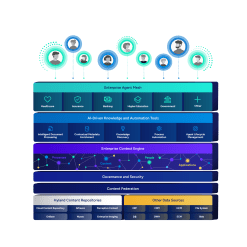What is optical character recognition (OCR) technology?
The demand for accurate business data on demand only grows each day. OCR technology gets mission-critical information to your team without slowing down workflows.

Harness the power of a unified content, process and application intelligence platform to unlock the value of enterprise content.
Learn more
Automate your document-centric processes with AI-powered document capture, separation, classification, extraction and enrichment.
Learn about Hyland IDPIt's your unique digital evolution … but you don't have to face it alone. We understand the landscape of your industry and the unique needs of the people you serve.
 Overview of industries
Overview of industries
Countless teams and departments have transformed the way they work in accounting, HR, legal and more with Hyland solutions.
 Overview of departments
Overview of departments
We are committed to helping you maximize your technology investment so you can best serve your customers.
 Overview of services
Overview of services

Discover why Hyland is trusted by thousands of organizations worldwide.
Hear from our customers
Our exclusive partner programs combine our strengths with yours to create better experiences through content services.
Overview of partners
Find resources to power your organization's digital transformation.
Browse the resource center
Hyland connects your content and systems so you can forge stronger connections with the people who matter most.
Learn about HylandWith our modern, open and cloud-native platforms, you can build strong connections and keep evolving.
 Dig deeper
Dig deeper
Reading time minutes
The demand for accurate business data on demand only grows each day. OCR technology gets mission-critical information to your team without slowing down workflows.

Optical character recognition (OCR) technology is a business solution for automating data extraction from printed or written text from a scanned document or image file and then converting the text into a machine-readable form to be used for data processing like editing or searching.
OCR software applications might operate slightly differently, but they do adhere to a few universal rules. OCR technology commonly works through a step-by-step process of:
A scanner reads physical paper documents and converts them into a scanned image. The file is commonly rendered in black and white, which will then be used to differentiate the brighter (background) and darker (characters) regions from each other.
Here, the OCR engine corrects errors through methods like de-skewing, binarization, zoning and normalization to improve the accuracy of scanned images.
Artificial intelligence (AI) tools can be used here to identify original characters from a scanned image or document. This can be done through two main algorithms, pattern matching and feature extraction.
The OCR software then converts the extracted data into electronic documents. Advanced OCR systems can compare extracted data against a glossary or library of characters to ensure maximum accuracy.
The various types of OCR technologies can be categorized based on what they can capture. These include:
Almost any type of image containing written text (typed, handwritten, or printed) can be transformed into machine-readable text data using OCR technology. The data can then be used to streamline operations, automate procedures and boost efficiency.
Organizations can leverage OCR tools to improve:
Businesses that employ OCR capabilities to convert images and PDFs (typically originating as scanned paper documents) save time and resources that would otherwise be necessary to manage unsearchable data. Once transferred, OCR-processed textual information can be used by businesses more quickly and easily.
The benefits of OCR technology to businesses include:
OCR adds the functionality of editing and searching materials from a digital archive. OCR-processed digital files, (such as receipts, contracts, invoices, financial statements, etc.) can be:
Security is a major concern for all companies that handle the digital data of their customers. OCR technology provides an extra layer of security when processing and extracting information. The banking sector, for instance, can digitize paperwork with greater accuracy through OCR. OCR ensures that data extraction and verification can happen faster, minimizing the risks of fraud, identity theft or manual errors.
Accessing, sharing and storing physical documents will lead to costly bottlenecks. Businesses can utilize OCR software to go paperless and automate mission-critical workflows daily. The right data capture system will allow your teams to automatically extract, validate and classify data in much less time than they could manually.
OCR, the ability to extract machine-printed text from a digital image, is only one aspect of a data capture solution. Data can be extracted from documents in many different formats — hand printed text (ICR), check boxes (OMR), bar codes, etc.
Robust data capture solutions handle multiple document formats and can be used with both electronic and paper documents, eliminating paper and reducing manual identification and data entry of document content into other systems.
By employing an OCR system within a data capture solution, businesses can: